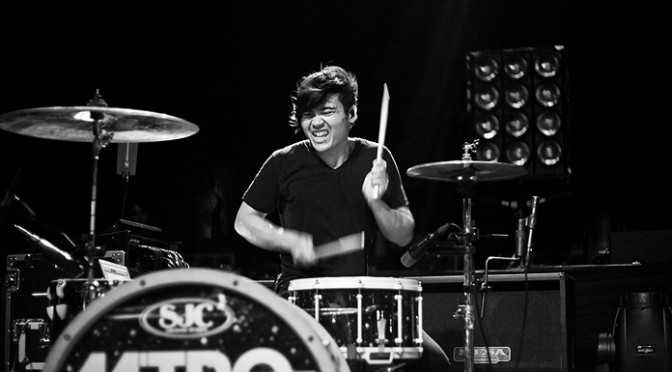
The drum set—or drum kit—is one of the most difficult instruments to mic up for a live performance. The principal reason for this difficulty is that a drum set is a multi-faceted piece of equipment, with each piece delivering its own distinctive sound. As such, it is crucial you use the correct microphone for every part of the drum set, and position them in a way that ensures the most desired sound, without conflicting with the other band instruments on stage. In the following article we will outline the several steps required to mic up each part of the drum set for a live performance.
How to Mic a Drum Set for Live Performance
The Overhead Mic
Before you begin to mic each individual drum and the cymbals, you will want to place a fairly large dynamic microphone about 1 foot to 18 inches directly over the seat in which the drummer will sit. This is the most important mic in the entire setup.
Kick Drum
The kick drum creates an enormous amount of sound pressure. Because of this, it’s important you select a mic with a high SPL rating, preferably a “wide-diaphragm dynamic microphone.” There are three placement options for the kick drum mic:
- Directly inside the drum, pointed about 2-3 inches from where the beater makes contact with the batter head
- One to two inches outside the hole in the resonant head
- Below the drum throne
The Snare Drum
The best mic for the snare drum is a cardioid (heart-shaped) or hypercardioid dynamic microphone. When placing this dynamic mic, you will get the best results if you locate it just marginally above—about one inch—and inside the rim of the drum itself, with the mic pointed at the drum head at an angle of roughly 30-60 degrees. Take care that you place the mic at an angle where it will not be accidentally hit, and perhaps even dislodged, by the drumsticks.
The Toms
Just like the snare drum, you will receive the best sound from the toms when you use a dynamic mic, either heart-shaped or hypercardioid. With larger toms, be sure to select a mic which is fairly sensitive in low frequencies. When placing the microphones for the tom drums, aim for about one to two inches from the skins, again at an angle aimed to avoid accidental contact with the drumsticks.
The Hi-Hat Drum
As the Hi-Hat drum can usually be picked up by the overhead mic, it is often unnecessary to mic this drum at all. If you do choose to mic the Hi-Hat, use a small pencil-shaped condenser microphone, placed about 3-4 inches above the drum.
The Cymbals
The cymbals, like the Hi-Hat drum, are usually present enough to be picked up nicely by the overhead mic. However, if you do choose to mic the cymbals individually, a good choice is a (very) small condenser microphone. These should be placed a good 3-4 inches above each cymbal, and angled out to avoid contact with the drumsticks.
As you can see, the process for microphoning a drum set is pretty easy and straightforward. Of course, if you’re just a beginner, it is not absolutely necessary to mic up each individual drum. Instead, start with a good dynamic overhead microphone, as well as two dynamic microphones for the kick and snare drum, respectively.
This article was written by our friends over at ZingInstruments.com.
Are you a guitarist? Check out our full range of online guitar lessonsAre you a saxophonist? Check out our full range of online saxophone lessons
Subscribe to Pro Music Tutor from as little as £7.99 per month
Related Posts
-
Why You Should Be Learning a Second Instrument
Learning your first instrument can sometimes feel impossible. Why on earth would you want to learn a second? I’m going to use this article to convince you that learning a second instrument is not only a great use of your time, but it may be better than spending time with your first instrument! Considering the […]
View All >> -
5 Easy-to-Learn Guitar Riffs to Impress Your Friends
When you’re first starting out learning how to play the guitar, it can be quite frustrating to stay motivated. It’s practicing the same chords, the same strumming and fingerpicking patterns, the same scales and songs over and over. It’s also pretty hard to impress your friends or girls with your noob skills, so ultimately you […]
View All >>
Latest Blog Entries
-
The Benefits of Online Music Education
Learning music has never been easier, since the internet and modern technological advancements have opened the doors to countless possibilities, expanding the subjects people can choose from and how the lessons are taught. Now, people can study a whole host of music-related topics; from learning to play guitar or DJing, to understanding the inner workings […]
View All >> -
Essential Jazz Guitar Scales that are Easy to Learn
Improvising in jazz requires the ability to play in different keys over different chords. Results certainly do not come overnight, but with diligent practice, you would be surprised by what you can achieve. Many people ask me about what scales I use as if they were some big secret. While knowing your scales is very […]
View All >>
Blog Categories
- Categories
- Guitar Tips (93)
- History (36)
- How-To (38)
- Interviews (3)
- Music Industry (121)
- Prolinks Guitar (2)
- Prolinks Lessons (3)
- Prolinks Tutor's Profile (1)
- Saxophone Tips (40)
- Uncategorized (6)
Tags
Archive
- November 2018 (1)
- February 2018 (1)
- December 2017 (1)
- November 2017 (1)
- October 2017 (1)
- July 2017 (4)
- May 2017 (2)
- April 2017 (1)
- August 2016 (2)
- July 2016 (1)
- June 2016 (2)
- May 2016 (3)

